


Here's some sims of my current iteration of the horn.
The sims show the response of the horn, versus the same driver (Dayton NS52) in a sealed box.
Here's some things I notice:
1) Efficiency has gone up by about eight decibels
2) phase response of the horn is similar to the sealed box, which is very good
3) Power handling of the horn is higher than the sealed box IF you use a highpass filter. A highpass of 300hz will allow for power handling of approximately 20V, or 100 watts into a 4ohm load.
The simulated response reflects the output with 100 watts into 4ohms, and shows that two of these horns should allow for about 120dB of output. More than enough for a car IMHO 🙂

The horn parameters were determined with Eazy Horn. It's less than three quarters of a liter. To give you an idea of how small that is, that's a cube that measures 3.5" x 3.5" x 3.5"(!!!)
The horn length is 29.5cm, so the actual size is very deep, very wide, and very short. Similar to one of these:
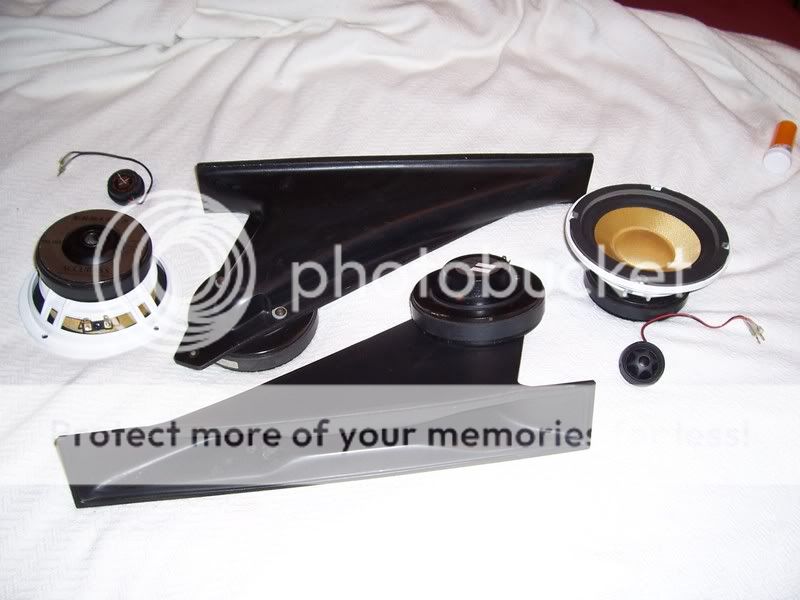
The thread has been a bit quiet, as I ran into an engineering challenge. Basically I want to do an underdash Unity horn. But the only practical way to reduce the size of the horn is to use the smallest drivers possible. (Big drivers need big horns, so conversely a horn can be reduced via the use of very small drivers.)

My original plan was to use a Celestion compression driver, along with the Dayton RS52 for the midrange.
I was having a heck of a time finding my Celestions, since I just moved. So I decided to try out the BG NEO 3.
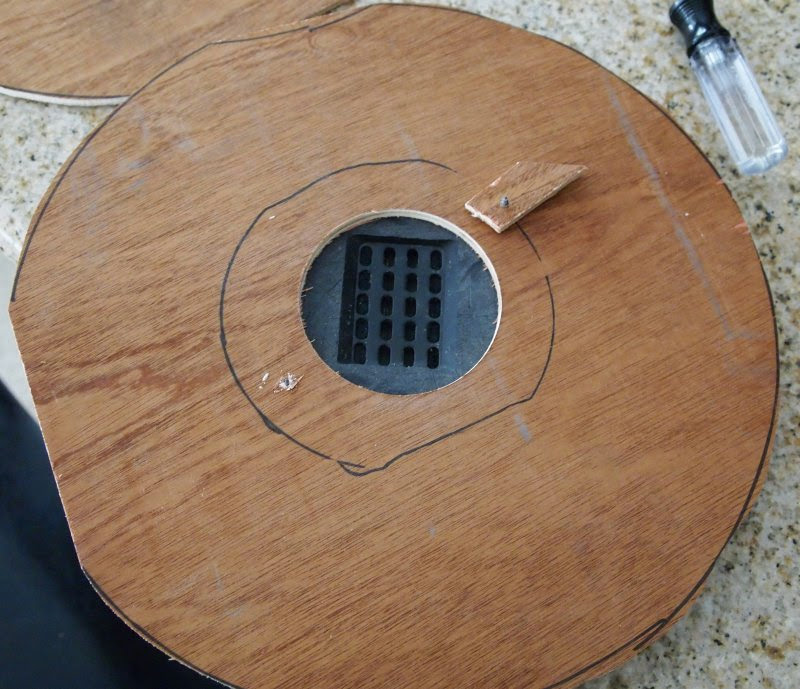

^^^ Here's some pics of the Neo3 in a very simple radial horn. And by "simple" I mean literally two 12" discs with the Neo3 in the center.

I listened to the Neo3 radial horn for a few hours, and since it sounded quite decent, I added some clay to improve the transition at the throat:

Here's the frequency response of the radial NEO3 horn, before and after the application of clay to the throat:


My original plan was to use a Celestion compression driver, along with the Dayton RS52 for the midrange.
I was having a heck of a time finding my Celestions, since I just moved. So I decided to try out the BG NEO 3.


^^^ Here's some pics of the Neo3 in a very simple radial horn. And by "simple" I mean literally two 12" discs with the Neo3 in the center.

I listened to the Neo3 radial horn for a few hours, and since it sounded quite decent, I added some clay to improve the transition at the throat:

Here's the frequency response of the radial NEO3 horn, before and after the application of clay to the throat:

To my ears, the NEO3 radial horn was very listenable, but didn't measure well. I wanted to investigate why this was. My 'hunch' was that the planar driver had a better decay, when compared to a conventional compression driver.
(Again, this was just my 'hunch.')

So I decided to pit the NEO 3 radial horn against a compression driver on a decent horn.


The graphs above show the results. The first measurement is Dayton's DE250 clone, mounted on an 18Sound xt1086 horn. Second measurement is my cheesy B&G NEO3 on my crude radial horn.
The NEO3 horn is exhibiting all kinds of weird comb filtering, as seen by the numerous peaks and dips across it's bandwidth. (But it sounds good!)


Here's the waterfall plots of the two horns. It turns out my 'hunch' was completely backwards. The 18Sound horn decays much faster than the NEO3 radial horn.
I'm not sure how to explain the disconnect between the measured results and how the horn sounds. The research from Geddes indicates that higher order modes sound bad. But perhaps it's frequency related? For instance, perhaps it's worse to have HOMs at one or two frequencies, when the rest of the bandwidth is clean. If you look at the waterfall of the NEO3 horn, you see a TON of higher order modes, as demonstrated by the slooooooow decay. But the decay is *consistent*, and perhaps this makes a difference in the sound.
It's odd, because the horn doesn't sound 'congested' or 'grungey.'
(Again, this was just my 'hunch.')
So I decided to pit the NEO 3 radial horn against a compression driver on a decent horn.


The graphs above show the results. The first measurement is Dayton's DE250 clone, mounted on an 18Sound xt1086 horn. Second measurement is my cheesy B&G NEO3 on my crude radial horn.
The NEO3 horn is exhibiting all kinds of weird comb filtering, as seen by the numerous peaks and dips across it's bandwidth. (But it sounds good!)


Here's the waterfall plots of the two horns. It turns out my 'hunch' was completely backwards. The 18Sound horn decays much faster than the NEO3 radial horn.
I'm not sure how to explain the disconnect between the measured results and how the horn sounds. The research from Geddes indicates that higher order modes sound bad. But perhaps it's frequency related? For instance, perhaps it's worse to have HOMs at one or two frequencies, when the rest of the bandwidth is clean. If you look at the waterfall of the NEO3 horn, you see a TON of higher order modes, as demonstrated by the slooooooow decay. But the decay is *consistent*, and perhaps this makes a difference in the sound.
It's odd, because the horn doesn't sound 'congested' or 'grungey.'
Would you say the Neo sounds more lush or warmer than the compression driver? This might answer why you like the Neo's sound. All those modes might make for a more euphoric replay.
Would you say the Neo sounds more lush or warmer than the compression driver? This might answer why you like the Neo's sound. All those modes might make for a more euphoric replay.
The only word I could use to describe it is "listenable."
I'm fairly in tune with the sound of harmonic distortion, and I know that distortion can often make a speaker sound *more* pleasant, not worse. But that's not the sound I am hearing.
I have my Gedlee Summas sitting here, and I'm fairly 'tuned in' to the sound of HOMs. The thing that's interesting about the three speakers is that the 18Sound definitely sounds like it has more HOMs than the 18Sound. But the sound of the NEO3 radial horn is different. To my ears, better than the 18Sound, but nowhere near as good as the Summa.
Admittedly, the measurements of the NEO3 look terrible, which is one of the things that's so confounding.
Possibly the answer lies in this thread:
http://www.diyaudio.com/forums/multi-way/177403-linkwitz-orions-beaten-behringer-what.html
^^ that thread does a great exploration of how reflected sound in the room may be euphonic.
I know that a *lot* of people hate Bose, but I have grudging respect for the company because I have a hunch that they've studied peoples preferences for certain distortions. For instance, Bose speakers frequently depends on a lot of reflections in the room, and there may be something about reflections that 'masks' problems in the loudspeaker.
My hunch (and it's just a hunch) is that the reflections may mask problems, similar to how masking is used in MP3 compression.
According to Wikipedia*, "Simultaneous masking occurs when a sound is made inaudible by a noise or unwanted sound of the same duration as the original sound.[2] For example, a powerful spike at 1 kHz will tend to mask out a lower-level tone at 1.1 kHz. Also, two sine tones at 440 and 450 Hz can be perceived clearly when separated. They cannot be perceived clearly when presented simultaneously."
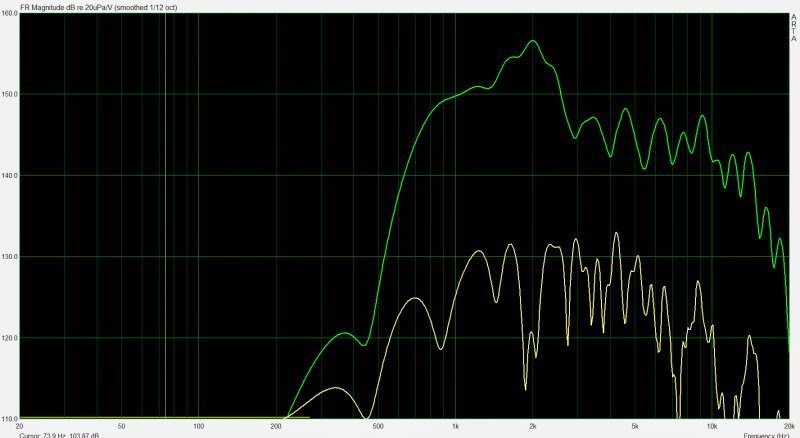
So perhaps that explains why the response of the NEO3 horn is crappy, but it still sounds good. Although there are deep nulls across the entire bandwidth, those nulls are not audible with music, because music is broadband. The pic above shows the response of the 18Sound horn, and the Neo3 radial horn. Both horns measured with the same 1/12th per octave smoothing, but note that the 18Sound doesn't have the deep nulls that the Neo3 does.
More interesting, is the possibility that this masking happens in both the frequency domain *and* the time domain. That might indicate why a lot of people prefer the sound of omnidirectional loudspeakers. (Like this radial horn I have sitting here.)
* Auditory masking - Wikipedia, the free encyclopedia
Edit -
the sentence "The thing that's interesting about the three speakers is that the 18Sound definitely sounds like it has more HOMs than the 18Sound."
should say:
"The thing that's interesting about the three speakers is that the 18Sound definitely sounds like it has more HOMs than the Summa."
the sentence "The thing that's interesting about the three speakers is that the 18Sound definitely sounds like it has more HOMs than the 18Sound."
should say:
"The thing that's interesting about the three speakers is that the 18Sound definitely sounds like it has more HOMs than the Summa."
In post 25, I showed the response of an 18Sound horn versus a radial horn using the Neo3.
While a number of people on these forums have recommended that I use a plain ol' conical horn, like Danley does, that option isn't easy to do in a car. This is due to the limited locations.
For instance, if you use a symmetrical waveguide like the SH-50, the waveguide has to be insanely shallow to fit in a car. Probably the deepest symmetrical waveguide I could install is something like this JBL:
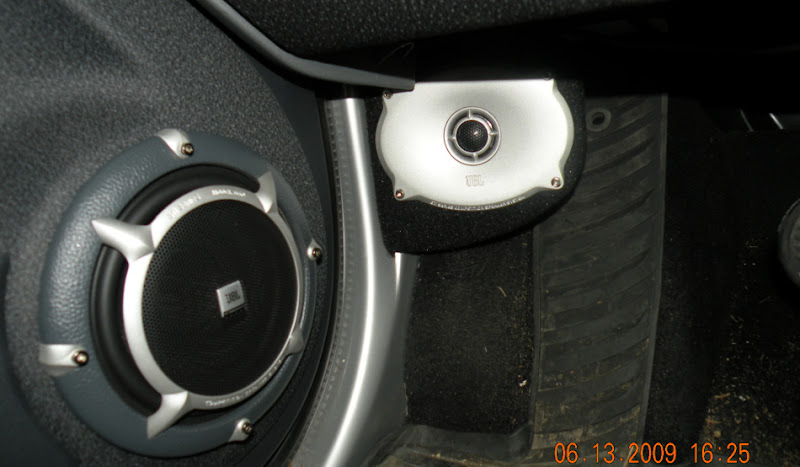
If I use an assymmetrical horn, I can use a much, much larger horn, because it fits under the dash:

My gripe with these types of horns is that it's hard to make them into Unity horns. The mids need to 'tap' in at a point where the area of the horn is four or five times larger than the throat. And in the Image Dynamics HLCDs, that would mean that the taps would be too far forward of the throat.
An obvious alternative would be to make the height of the horn taller. That reduces the asymmetry, and that increases the volume of the horn. Unfortunately, a 3" tall horn beams at 4500hz and up. So all the high frequency energy is aimed right at your knee caps. Can you say "pattern flip?"
I *really* like the VTC Paraline design; I think that you can scale the horn down to use smaller drivers and the expansion rate of the Paraline solves a lot of problems in the car. It has a slow expansion for the first few inches, which is good for our high frequencies, and then a rapid expansion near the midbasses, which is good for our low frequencies.
The big problem with the Paraline is sound quality. I've definitely made some that sound great, but there's still lots of issues. It's hard to be 100% sure what the main problem is. Is it distortion? The frequency response? The high frequency droop? Pattern flip?
In a discussion on another thread*, David L Smith (formerly of Snell) mentioned that the polars of the JBL biradials were very well behaved. This piqued my curiosity, as the biradials don't really look like a horn; the majority of the horn is actually defined by two half-spheres that sit outside of the enclosure:

That got me thinking that we could do something similar with the SAW lens that B&O uses. Probably the best information on that lens is in this patent:
https://www.google.com/patents/US6820718

So it seemed to me, I might be able to take the lens from the Beolab, flip it upside down, and put it underneath the dash. That would offer the following advantages:
1) The footprint is very very small
2) The underside of the dash and the firewall of the corner constrains the output of the drivers in two dimensions; so we should get significant gain. This is similar to the corner loading used by Klipsch
3) The part that's the most interesting to me is that the reflector in the Paraline is that the same as the reflector in the Beolab. As I see it, they're both constant directivity horns really. Most constant directivity horns from the last couple decades have two stages. The first stage has a slow flare rate; the second stage expands very quickly. The Paraline and the Beolab lens work the same way. The first stage expands slowly; the second stage expands quickly. The difference with the Paraline and the Beolab is that the sound is bounced off a reflector.

As Danley noted in my Square Pegs thread, these microwave horns inspired the Paraline, and it's the same shape in the SAW lens.
While a number of people on these forums have recommended that I use a plain ol' conical horn, like Danley does, that option isn't easy to do in a car. This is due to the limited locations.
For instance, if you use a symmetrical waveguide like the SH-50, the waveguide has to be insanely shallow to fit in a car. Probably the deepest symmetrical waveguide I could install is something like this JBL:

If I use an assymmetrical horn, I can use a much, much larger horn, because it fits under the dash:

My gripe with these types of horns is that it's hard to make them into Unity horns. The mids need to 'tap' in at a point where the area of the horn is four or five times larger than the throat. And in the Image Dynamics HLCDs, that would mean that the taps would be too far forward of the throat.
An obvious alternative would be to make the height of the horn taller. That reduces the asymmetry, and that increases the volume of the horn. Unfortunately, a 3" tall horn beams at 4500hz and up. So all the high frequency energy is aimed right at your knee caps. Can you say "pattern flip?"
An externally hosted image should be here but it was not working when we last tested it.
I *really* like the VTC Paraline design; I think that you can scale the horn down to use smaller drivers and the expansion rate of the Paraline solves a lot of problems in the car. It has a slow expansion for the first few inches, which is good for our high frequencies, and then a rapid expansion near the midbasses, which is good for our low frequencies.
The big problem with the Paraline is sound quality. I've definitely made some that sound great, but there's still lots of issues. It's hard to be 100% sure what the main problem is. Is it distortion? The frequency response? The high frequency droop? Pattern flip?
In a discussion on another thread*, David L Smith (formerly of Snell) mentioned that the polars of the JBL biradials were very well behaved. This piqued my curiosity, as the biradials don't really look like a horn; the majority of the horn is actually defined by two half-spheres that sit outside of the enclosure:
That got me thinking that we could do something similar with the SAW lens that B&O uses. Probably the best information on that lens is in this patent:
https://www.google.com/patents/US6820718

So it seemed to me, I might be able to take the lens from the Beolab, flip it upside down, and put it underneath the dash. That would offer the following advantages:
1) The footprint is very very small
2) The underside of the dash and the firewall of the corner constrains the output of the drivers in two dimensions; so we should get significant gain. This is similar to the corner loading used by Klipsch
3) The part that's the most interesting to me is that the reflector in the Paraline is that the same as the reflector in the Beolab. As I see it, they're both constant directivity horns really. Most constant directivity horns from the last couple decades have two stages. The first stage has a slow flare rate; the second stage expands very quickly. The Paraline and the Beolab lens work the same way. The first stage expands slowly; the second stage expands quickly. The difference with the Paraline and the Beolab is that the sound is bounced off a reflector.

As Danley noted in my Square Pegs thread, these microwave horns inspired the Paraline, and it's the same shape in the SAW lens.
Last edited:
I can't believe it's been ten days since I've updated this thread!
I actually tried a bunch of things:
1) something that looks like the Beolab, but with a compression driver
2) a number of variations on that, using the lens without the 'hat', without the lens, etc
I ended up settling on something that's fairly similar to what Beolab does with their midranges:

We see the following features:
1) midrange at apex of SAW lens
2) baffle behind the driver that's twice the width of the piston (very important! without the baffle the directivity is all wrong)
3) curvature of the lens is a fibonacci spiral
More details on this here: http://www.diyaudio.com/forums/multi-way/163015-cloning-3200-speaker-400-a-7.html#post3606289



Here's some pics of the device coming together. It's still in process, but I'm listening to it while it's coming together. The midrange on the Fostex is really nice, and reminds me of the things I like about my Unity horns (articulation, the ability to extract things out of a recording that regular speakers do not.)
My underdash unity horns often suffer from throat distortion, due to the horns being so short vertically. So the reflector from the Beolab is a great innovation here.
I actually tried a bunch of things:
1) something that looks like the Beolab, but with a compression driver
2) a number of variations on that, using the lens without the 'hat', without the lens, etc
I ended up settling on something that's fairly similar to what Beolab does with their midranges:

We see the following features:
1) midrange at apex of SAW lens
2) baffle behind the driver that's twice the width of the piston (very important! without the baffle the directivity is all wrong)
3) curvature of the lens is a fibonacci spiral
More details on this here: http://www.diyaudio.com/forums/multi-way/163015-cloning-3200-speaker-400-a-7.html#post3606289
Here's some pics of the device coming together. It's still in process, but I'm listening to it while it's coming together. The midrange on the Fostex is really nice, and reminds me of the things I like about my Unity horns (articulation, the ability to extract things out of a recording that regular speakers do not.)
My underdash unity horns often suffer from throat distortion, due to the horns being so short vertically. So the reflector from the Beolab is a great innovation here.

Here's a quick measurement of the lens, on axis and 180 degrees off axis. Some observations:
1) The on-axis response is starting to look like a constant directivity horn, with the sloooow high frequency rolloff. This makes sense, since the lens is scattering the high frequency energy across the room.
2) I'm pleasantly surprised by how good the rejection to the back is. Radiation to the back is attenuated by about 10dB.
Obviously, response has lots of peaks and dips, but I anticipate that the peaks and dips will be reduced one I add a roundover to reduce diffraction.


Here's what it looks like right now. Still lots of rough edges here, and it was measured with the clamps holding it together. Only the bottom half of the lens is complete; the top half of the lens is just a plain ol' 45 degree reflector. (For now.) I'm certain there's still lots of improvements to be made.
Last edited:
3D printing would be the easy way to make such a lens 🙂
I don't disagree; but I'm good with wood, fiberglass, and foam.
I'm semi-decent with 3D programs, but I'm slooooow in 3D. I can knock out a 2D design in a matter of minutes.
This is mostly due to my job; at work I have to do 2D designs for networks routinely, so doing 2D designs for DIY projects comes natural. I never have any reason to do things in 3D at work, so when I do things in Blender it takes fo-rev-er.

Sausalito Audio Works lens (DIY) - YouTube
Here's a video of the SAW lens playing the confrontation between Walt and Hank in Breaking Bad (spoiler alert! don't watch if you're not caught up.)
Some observations:
1) This is only one driver, a Fostex FF85WK, but we're getting real output all the way to 20khz.
2) Even I was surprised by the bandwidth; the SAW lens and the platters act like an oddly shaped constant directivity horn. And we *do* see the tell-tale high frequency roll off on axis. But due to the relative lack of comb filtering, the bandwidth is much broader than you would typically see with a 3" woofer in a front loaded horn.
3) In the video, you may hear some distortion as the camera gets close to the speaker, but that's the mic distorting, not the speaker. I had these things CRANKED UP. Was probably feeding them close to fifty watts. (They're rated for five :O )
4) There's a sound like crickets, but that's actually in the recording, from the show
5) Note how quickly the response falls off at the edge of the SAW lens, but how it's basically the same level as I move the phone left to right, and then there's an abrupt 10dB drop at 90 degrees off axis.
Diy sausalito audio works lens - YouTube
Here's a crappy recording I did of some Bassnectar. At the 0:34 second mark the sound gets weird; I think I accidentally covered up the mic on my phone. But it gives you an idea of the output level and the dynamics. This recording uses one of the SAW lenses crossed over at 100hz to my TH-Mini clone. So this is a two way set.
The SAW lens would be an interesting way to top a horn loaded driver, since the bandwidth on the lens is so broad. Picture a Fostex FF85WK hooked up to a tube amp for the highs, with a stereo solid state amp running the horns below it. MiniDSP could be useful for frequency shaping and digital delay, since the horn would need the delay to stay in sync with the SAW lens. (Since the pathlength on the SAW lens is inches, and the pathlength on the horn is feet.)
Last edited:
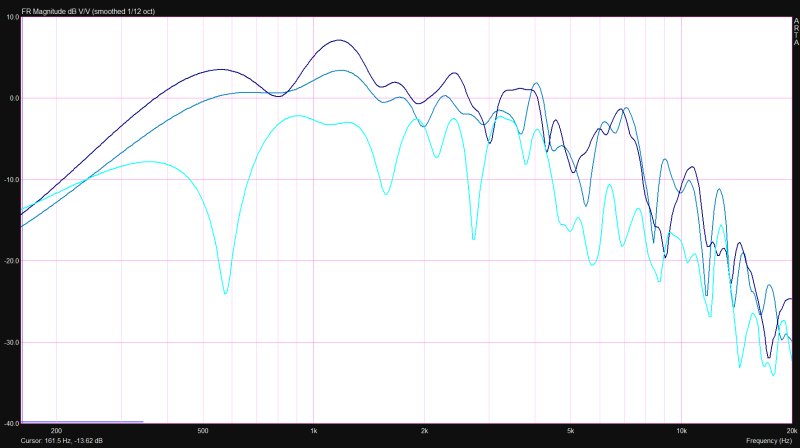
Here's the on axis response, 45 degrees off axis, and 90 degrees off axis.
Some observations:
1) Looks a lot like the response of a constant directivity horn
2) 45 degrees off axis and on axis are within +/- 3dB of each other all the way to 20khz. So this thing is definitely working, despite it's crude construction. Note that even a 1" compression driver on a horn can't do this; the directivity of a 1" compression driver collapses at 13,500 hz due to the 1" throat. You can see that here:
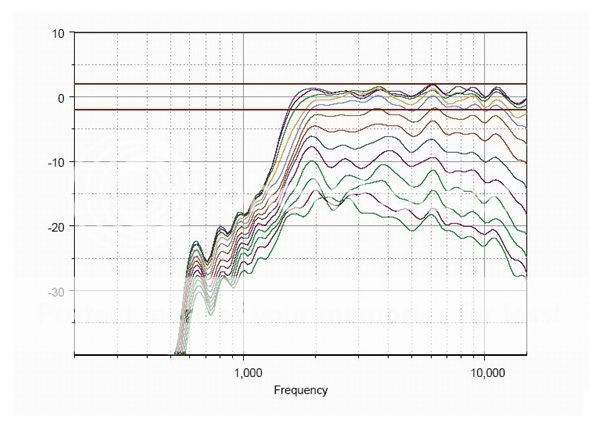
^^ see how a waveguide collapses at 13,500hz? Not a huge deal, but kinda 'neat' that the SAW lens doesn't.
3) The response 90 degrees off axis is down between 5-15dB, so this thing definitely *isn't* omnidirectional. But I don't *need* omnidirectional. I just want wide horizontal coverage, and narrow vertical.
That's very interesting. Have you considered replacing the the cone driver with a compression driver? Best regards Moray James.
That's very interesting. Have you considered replacing the the cone driver with a compression driver? Best regards Moray James.
Yes, a compression driver would work great.
Main reason I tried the Fostex is *size*. In the car, there's very little depth to work with, so the combination of lens and driver has to be shallow.
Right now I'm listening to the lens loaded with a Dayton RS28, and I'm leaning towards that as a solution.
The Fostex works well, but it's just a little too tall.
Ideal driver would be something about 2" in diameter that can get to 20khz without any breakup modes, that can take a lot of power.
Just off the top of my head, some candidates, and why they won't work:
1) Peerless has some 2" drivers that get to 20khz. But their power handling isn't as good as the RS28, even though they have more displacement capability.
2) The Dayton 2" dome would be a no brainer, if it wasn't for that stupid breakup mode at 10khz
3) Dayton ND91 is a drop-in replacement for the Fostex FF85WK, even the bolt pattern is the same. But due to it's high excursion, it's much deeper.
Actually a compression driver without the phase plug might be a good candidate. The Celestion CDX1-1425 has a 1.4" aluminum dome (under the phase plug), and they sell another model that has a 1.5" or 2.0" poly dome under the phase plug. Can't recall the model #, it's the one that Bill Waslo uses in his Synergy horns.
An externally hosted image should be here but it was not working when we last tested it.
Here's some experiments with the Dayton RS28.

^^ Here's the exact same lens, loaded with the Dayton RS28 instead of the Fostex FF85WK.
Yellow is the Fostex, red is the RS28. I scaled the RS28 up by 10dB, to make the graph easier to read.
We see that the shape with the RS28 is a little bit trickier, because it doesn't have that nice smooth rolloff of the Fostex. If I had to guess, this is because the lens was specifically sized for the Fostex, not the RS28. (IE, the lens needs to be about half the size to get that nice smooth rolloff that we see with the Fostex.)

Here's the same lens with the RS28. This time, I've added a 5uf cap to flatten out the response curve. For a 4ohm tweeter, that's equivalent to a crossover of 8000hz.
I'm listening to this combination right now, and there's a lot to like. I'm used to listening really LOUD, and the 8000hz crossover keeps excursion under control. At the same time, the top octave of the RS28 sounds more 'delicate' than my reference.*
In the graph, the green curve is on axis, the purple curve is 22.5 degrees off axis, and the orange curve is 45 degrees off axis.
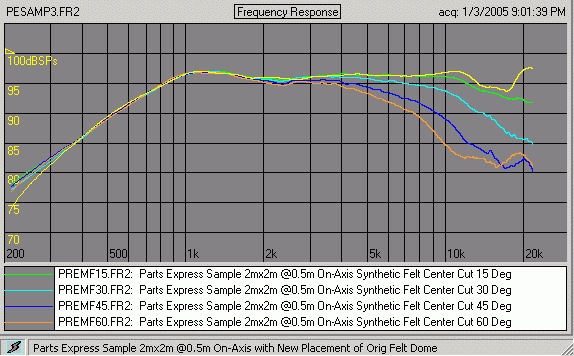
Here's the response of the same tweeter on a flat baffle. We seem that it's beaming quite a bit at 10,000hz, due to the diameter of the radiator.
An externally hosted image should be here but it was not working when we last tested it.
Here's the same driver on an 8" waveguide. Nice measurements, but it's not practical for my car; there's nowhere I can fit an 8" waveguide. My SAW lens is about 2" tall, so it fits under the dash nicely. (Now if only the driver was shallower...)
The very short height of the lens also allows for some ridiculously tight distances center-to-center. I could see a Unity or synergy horn spread out like this, with the lens at the center, like figure 9 in Danley's Paraline patent:

The last two measureemnts were taken from here:
horn tweeters in the home theater...advantages and disadvantages
* my reference speakers use a compression driver with a diaphragm that's something like 3" in diameter. There's only so much bandwidth that you can squeeze out of a single driver, and something's gotta give. This isn't a knock against my reference; just stating the obvious. If you want a compression driver to play to 900hz, you have to compromise somewhere.
Last edited:
Patrick,
The "Saw" lens is an interesting idea. Going back to your original plan to miniaturize a version of the Danley synergy horn, what is the lowest frequency response you are targeting? Have you tried using quantities of 4, 6, or 8 two inch drivers focused radially at the same point in the throat? Some of the Vifa 2" Neo magnet versions are pretty small. Also if you modified the kick panel area for more depth and width, the horn mouth could be made larger.
The "Saw" lens is an interesting idea. Going back to your original plan to miniaturize a version of the Danley synergy horn, what is the lowest frequency response you are targeting? Have you tried using quantities of 4, 6, or 8 two inch drivers focused radially at the same point in the throat? Some of the Vifa 2" Neo magnet versions are pretty small. Also if you modified the kick panel area for more depth and width, the horn mouth could be made larger.
Patrick,
The "Saw" lens is an interesting idea. Going back to your original plan to miniaturize a version of the Danley synergy horn, what is the lowest frequency response you are targeting? Have you tried using quantities of 4, 6, or 8 two inch drivers focused radially at the same point in the throat? Some of the Vifa 2" Neo magnet versions are pretty small. Also if you modified the kick panel area for more depth and width, the horn mouth could be made larger.

^^ In this measurement of the Fostex FF85WK in a SAW lens with 8"x12" platters, we have output down to about 280hz. For my application, that's fine; that's over six octaves of bandwidth with a single lens. Similar to the bandwidth of the 16" wide Lambda Unity horn.
The only real problem with the Fostex-loaded lens is the size; it's probably about an inch too deep. I *might* be able to squeeze it under the dash, but it's really not ideal.
The direction I'm leaning towards now is to put the Dayton RS28 at the Apex of the lens, and flank the Dayton with some small woofers. Using a 1" radiator at the apex makes the vertical height of the lens smaller, because the dimensions of the lens are based on the dimension of the radiator. (IE, the volume of a lens for a 3" radiator is nine times as big as the volume of a lens for a 1" radiator, because every dimensions is multiplied by three.
That would cut down on the height quite a bit.
I might use 2" woofers, but it would be great if I could find enough space to use 3" drivers.
One idea I had was to use the $2 Gento buyout woofers from Parts Express, and bandpass them to filter out their harmonic distortion. To me they sound kinda grungy. Having said that, I've only used them in Paralines, and it's possible that what I was hearing was throat distortion. (Since the expansion rate of a Paraline is so slow.) The SAW lens wouldn't suffer from that problem, since the expansion rate is very very fast, due to the wide coverage angle.

Here's the polar response of my SAW lens using a Dayton RS28 and a simple filter to flatten out the response and reduce excursion.

Here's the exact same lens, but this time using a NEO3 PDR as it's source. I tried this because I wanted to see if I could squeeze this onto the dash of my car, and the NEO3 is thinner than the RS28.
The good news is that the on axis and the off axis is the same shape. So the lens is doing what it's supposed to do. The bad news is that the response shape isn't flat. There's a nasty dip at 9500hz (1.42")

Here's the response of the SAW lens with a NEO3. This time, I filled the whole lens with reticulated foam. Oddly enough, the output off axis gets LOUDER, while the on axis response is basically the same.
Here's why I think this is happening:
9500hz is 1.42" long. A NEO3 is over 2" in diameter. Due to this, you get high frequency peaks and dips due to pathlength differences. For instance, you'd need a radiator that's less than 0.7" long to radiate 10khz in phase. (This is the reason that tweeters have phase plugs.)
Instead of using a phase plug, I believe the reticulated foam is reducing high frequency output by simple absorption. And since the radiation from one side of the radiator has to go further through the foam, particularly off axis, that's why we see the dip at 9500hz 'fill in' Make sense? Just plain ol' Pythagorean Theorem.

Here's the last experiment. It's a BG NEO3 in a SAW audio lens, just like the first two measurements. But this time I used reticulated foam to 'mask off' just half of the radiator.
The good news is that the high frequency polars look the best now. Bad news is a nasty dip at 5khz. (6.8cm). I'm betting this dip is due to a resonance between the baffle and the NEO3. I basically used the reticulated foam as a gasket between the baffle and the NEO3, and I'm guessing that a fraction of the sound is radiation into the cavity that's formed.
So I think that masking off part of the NEO3 using foam is a good idea, as long as you do it in such a way that it doesn't create a resonant cavity. (Perhaps glue it to the frame, instead of sandwich it like I did?)
Over on diymobileaudio, I spent some time pondering reflections on the dash.*
And after doing that for a few weeks, I decided the following:
1) sound is going to wrap around the enclosure once the wavelengths are big enough
2) Due to that, we want an enclosure that's very low in diffraction. Basically it would be great to eliminate the reflections, but since we can't do that, next best thing is to eliminate the diffraction that happens as it wraps around
What Genelec does looks like it would work nice.
Unfortunately, even this is too big for the car. Even with a 3" woofer and a 3" waveguide you can't get it up on the dash. Or at least not my dash.

This is what I came up with.
Same general idea as the Genelec, but with some of my own enhancements.
1) I didn't just tilt the drivers to make them fit in a smaller space; tilting the driver also aligns the radiators. With a 3" driver you don't need a lot of adjustment to get them in sync, just a centimeter or so. But raking the angle of the drivers accomplishes this just as easily as setting them backwards does
2) Using a sphere as the enclosure doesn't just reduce diffraction, it also allows me to rotate the enclosure without changing the shape of the footprint. (IE, a square enclosure has a different footprint if it's rotated 45 degrees than if it's rotated zero degrees.) This is a small thing, but up on the dash, there is very very little room.
3) I put a coupling chamber in front of the midrange, which is a Dayton ND91. The coupling chamber rolls off the highs and also allows tighter center-to-center spacing. Same idea as what Danley does in the Unity horn to pack the drivers tightly together.
4) You can't tell from the pic, but there's going to be a waveguide on the tweeter, just like the Genelec. The tweeter I'm using is a Dayton RS28.
Center to center spacing is very very tight. The gap between the radiators is 4.5cm. That makes the following crossover frequencies attractive:
1) 7500hz (one wavelength)
2) 3750hz (1/2 WL)
3) 1875hz (1/4 WL)
It might be possible to get it down to 1875hz, which would allow for really nice polars.
And after doing that for a few weeks, I decided the following:
1) sound is going to wrap around the enclosure once the wavelengths are big enough
2) Due to that, we want an enclosure that's very low in diffraction. Basically it would be great to eliminate the reflections, but since we can't do that, next best thing is to eliminate the diffraction that happens as it wraps around
An externally hosted image should be here but it was not working when we last tested it.
What Genelec does looks like it would work nice.
Unfortunately, even this is too big for the car. Even with a 3" woofer and a 3" waveguide you can't get it up on the dash. Or at least not my dash.

This is what I came up with.
Same general idea as the Genelec, but with some of my own enhancements.
1) I didn't just tilt the drivers to make them fit in a smaller space; tilting the driver also aligns the radiators. With a 3" driver you don't need a lot of adjustment to get them in sync, just a centimeter or so. But raking the angle of the drivers accomplishes this just as easily as setting them backwards does
2) Using a sphere as the enclosure doesn't just reduce diffraction, it also allows me to rotate the enclosure without changing the shape of the footprint. (IE, a square enclosure has a different footprint if it's rotated 45 degrees than if it's rotated zero degrees.) This is a small thing, but up on the dash, there is very very little room.
3) I put a coupling chamber in front of the midrange, which is a Dayton ND91. The coupling chamber rolls off the highs and also allows tighter center-to-center spacing. Same idea as what Danley does in the Unity horn to pack the drivers tightly together.
4) You can't tell from the pic, but there's going to be a waveguide on the tweeter, just like the Genelec. The tweeter I'm using is a Dayton RS28.
Center to center spacing is very very tight. The gap between the radiators is 4.5cm. That makes the following crossover frequencies attractive:
1) 7500hz (one wavelength)
2) 3750hz (1/2 WL)
3) 1875hz (1/4 WL)
It might be possible to get it down to 1875hz, which would allow for really nice polars.
- Status
- Not open for further replies.
- Home
- Loudspeakers
- Multi-Way
- 28 Days Later